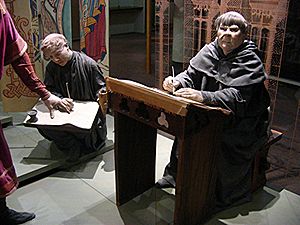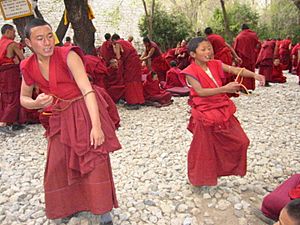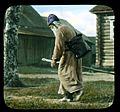Monk facts for kids


A monk is a man who chooses to dedicate his life to a religion. The word "monk" comes from an Ancient Greek word meaning "solitary" or "alone." While the Greek word could mean both men and women, in English, a woman who does this is called a nun.
Monks often practice something called asceticism. This means they choose to live a simple life. They might give up many normal comforts. Monks can live alone, like hermits. Or, they might live together with other monks. These groups live in special buildings called monasteries. Nuns live together in places called convents. You can find monks in many different religions. Some of the main ones include Buddhism, Christianity, Hinduism, Jainism, and Taoism.
Contents
What is a Monk?
A monk is a man who decides to live a very religious life. He often gives up many everyday things. This is to focus completely on his faith. Monks believe this way of life helps them grow closer to their religion's teachings. They want to understand their spiritual path better.
Living a Monk's Life
Monks follow certain rules or ideals. These rules help them live a focused and devoted life. They might choose to live alone, away from others. These monks are known as hermits. They seek quiet and peace for prayer or meditation.
Other monks live together in communities. These communities are called monasteries. Living together helps them support each other. They share their religious journey. They also share daily tasks and prayers.
Rules Monks Might Follow
Monks often choose to live by special rules. These rules help them stay focused on their spiritual path. Not all monks follow every rule. But these are common ideas they might live by:
Poverty
Many monks choose to live without owning much. This means they do not have personal possessions. They believe this helps them avoid distractions. It also helps them focus on spiritual wealth.
Chastity
Monks often promise not to marry. They also promise not to start a family. This rule helps them dedicate all their energy to their religious life. It means they can serve their community fully.
Solitude and Silence
Some monks try to be alone as much as possible. They seek quiet for deep thought. Other monks choose to speak only when necessary. They believe silence helps them listen better. It also helps them focus on inner peace.
Generosity and Duty
Monks often try to help other people. They believe in being kind and giving. They also have daily duties. These duties might include praying or meditating. They also do work to support their monastery. This work can be anything from cooking to gardening.
Stillness
Some monks choose not to travel far. They stay mostly within their monastery. This is sometimes called being "cloistered." It means they do not leave their religious home. This helps them keep a steady routine. It also helps them focus on their spiritual journey.
Images for kids
-
Portrait depicting a Catholic monk of the Carthusian Order (1446)
-
Buddhist monks in Thailand.
-
Monk resting outside Thag-Thok Gompa, Ladakh
-
Painting of a Franciscan monk, shown with a traditional tonsure hairstyle
-
The nave of the church at Jasna Góra Monastery, one of the last monasteries run by the Order of Saint Paul the First Hermit
-
The cloister of Lehnin Abbey, a former Cistercian monastery
-
Munich's city symbol celebrates its founding by Benedictine monks—and the origin of its name
-
Monastery of St. Dionysius on Mount Athos.
-
General view of Holy Trinity-Makaryev Monastery, on the Volga River in Nizhny Novgorod Oblast, Russia.
-
Monk near Saint Petersburg, Soviet Union (c., 1931) by a traveler DeCou, Branson.
See also
 In Spanish: Monje para niños
In Spanish: Monje para niños



















